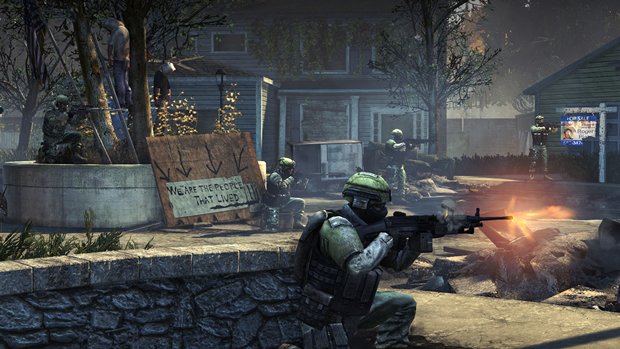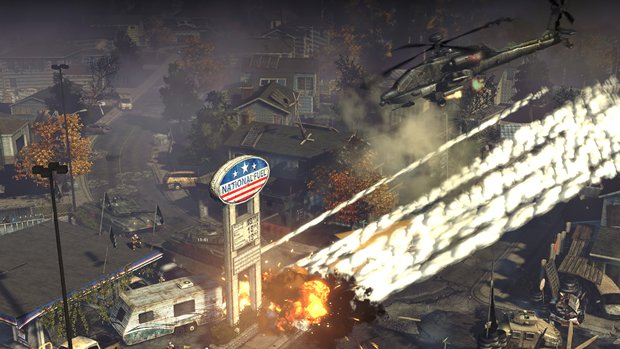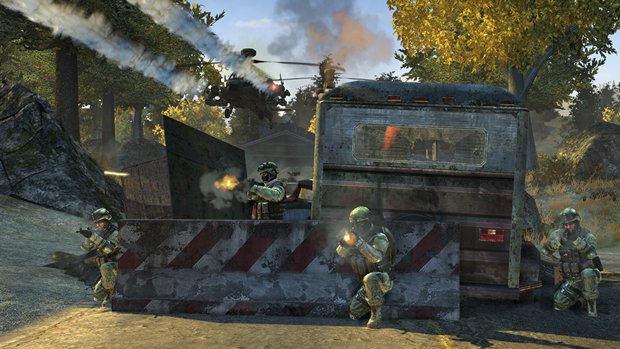Homefront hands-on preview
Never have we been killed so much by toy helicopters
Homefront strikes a rare nerve with its premise. The moment we began the single-player campaign, something unusual in videogames happened to us: we became terrified simply by a premise. Surely it has to do with a startlingly realistic idea that challenges the comfort of US supremacy in the modern era. We would imagine, though, that it has the potential for hitting a similar nerve for UK gamers, since although it doesn’t take place on “home” soil for those of you across the Atlantic, it still presents an unsettling, unfamiliar situation that neither the US nor UK has experienced in recent memory: military occupation. Considering how much occupying us westerners have been doing throughout the 20th century, will players of Homefront see opportunity for insight within its horrifying role reversal?

The main focus of our recent play time with Homefront was with the multiplayer, but because the game’s premise is central to its identity, we’ll talk a bit about the single-player first. Homefront is essentially a retelling of the guerilla-fantasy film Red Dawn, which today looks like a ridiculous, unrealistic exploitation of Cold War fears. In that film, a group of teenagers in Colorado somehow fight off the entire Soviet/Cuban invasion of America with guns, explosives, and the good ‘ol fierce American spirit. The most unrealistic part of the movie is not that these teenagers could kick so much ass, but that Russians could somehow fly all the way into the middle of the US and just parachute in without any resistance (and for that matter, why would Colorado be of any strategic importance?). Even so, to our child brains back in the 80s, it was chilling in its implications: aside from numerous alien invasions, we’d never really seen what it could be like to be invaded and occupied.
Homefront updates Red Dawn by having the invading force originate from North Korea. It also takes place in the near future, when depleting resources and a weakened US dollar lead to a vulnerable nation, which is quite realistic considering current global economic conditions and the myopic dependence on oil the US military is still clinging to. With the US distracted with its own problems, North Korea conquers South Korea and then proceeds to take over eastern Asia with its growing ranks of soldiers (and North Korea today already has a gigantic military considering the small population). The new Korean People’s Army, or KPA, then uses a satellite EMP to punch a hole in US defenses and launch an invasion, using Hawaii as a stepping-stone. Much more believable than Soviet planes just waltzing across thousands of miles of US territory bristling with anti-air defenses. We should note that the script is written by John Milius, scribe of Apocalypse Now and Red Dawn, so it seems he’s maintained his sense of the horrors of war while also stepping back and re-evaluating what worked in Red Dawn and what didn’t.

Homefront’s setup does something most FPS games don’t: it invests real motivation in you to overcome the enemy. It starts with you hiding out in a run-down apartment building, your only comfort a bare mattress. The KPA comes banging on the door, and before you can answer it they bash through and knock you out. You wake up on a bus, being taken somewhere – and you know it can’t be good. Along the way, the ordinarily quiet streets of America’s heart have turned into a landscape of terror: citizens kneel with hands on heads as soldiers bark threats at them, KPA can be seem casually tossing bodies into a mass grave, and in one of the most shocking moments we’ve ever seen in a videogame, two parents are executed in front of their small child, who’s left crying on the street corner as the soldiers walk away.
It is, then, that we fought with particular vigor once guerillas hit our bus and freed us from probable doom. In its fundamental mechanics, Homefront isn’t any different than other “real-world” shooters, so it comes down to how appealing its premise is – how horrifically realistic do you want your shooter to be? So far, we have to praise its audacity at attempting serious storytelling.
All of this setup becomes a bit of a question mark when we switch to multiplayer. The setting retains its relevancy – battles are fought on Midwestern farms, tranquil suburbs, and other icons of what most players consider normally safe places, instead of parking garages, office buildings, and oil derricks, which have become videogame shorthand for the OK Corral. Yet gone are the civilians in peril, leaving a typically empty arena-style environment in which to score headshots. The game goes from being a grave meditation on US occupation policies and the moral ambiguities of insurgent forces to simply a shooter where noobs and pros vie for digital dominance. When we think about it, maybe AI civilians in peril could have spiced things up – we’re thinking Hostage game modes from Counter-Strike.

There are two key components that separate Homefront’s multiplayer from the FPS pack: Battle Points and drones. Battle Points are earned through actions relevant to the game type. Simply killing enemies won’t score you much, so going after objectives becomes critical. Once you earn BP, a quick tap of the relevant purchase button and you now have a drone, a flak jacket, or a rocket launcher. Homefront features the standard leveling system, and so higher levels unlock more interesting and powerful purchase options. After a few levels you’ll be able to purchase a Humvee, while later levels unlock APCs, tanks, and helicopters. These vehicles can’t be bought in the middle of battle like the smaller items because it wouldn’t be fair if you could suddenly spawn a tank on top of yourself in a firefight. So, instead you can purchase vehicles at the respawn screen. Taking a cue from Battlefield Bad Company, Homefront also allows you to instantly spawn inside a friendly vehicle, although we didn’t see other, on-foot, team spawning options.
Sign up to the GamesRadar+ Newsletter
Weekly digests, tales from the communities you love, and more



